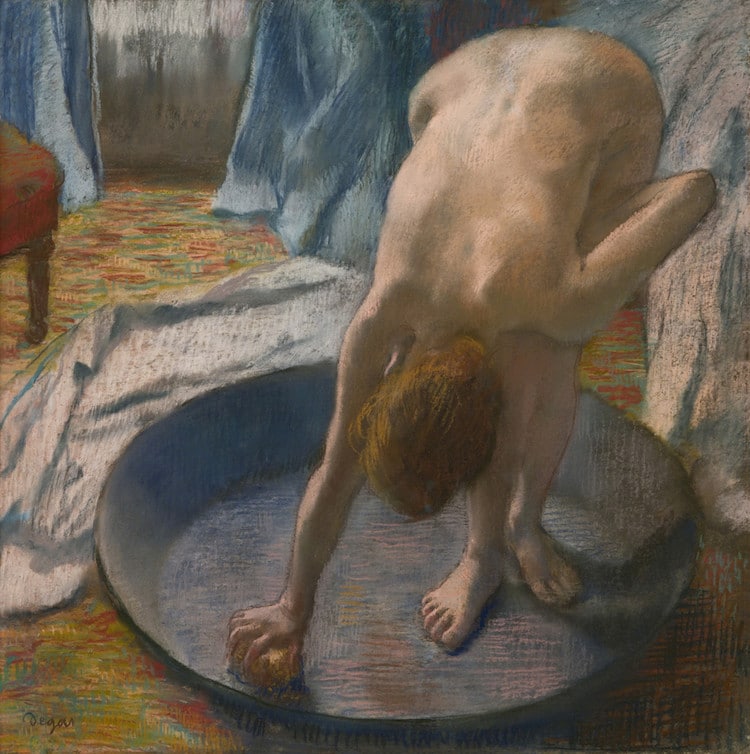
Mary Cassatt, “Woman Bathing (La Toilette),” 1890-1891 (Photo: Wikimedia Commons [CC0 1.0])
For centuries, artists have drawn endless inspiration from the humble bather. Whether washing in a tub, in a basin, or at the sink, the bathing figure has popped up in art since ancient times, culminating in a muse that appears to float above the rest.
In order to understand why such a seemingly simple subject has had such a long-running history, it's important to trace its artistic evolution. Here, we reflect on the role of the bather in art, wading through age-old sculptures, contemporary paintings, and other works that have made a splash.
See how bathers have surfaced in some of art history's most significant art movements.
Classical Antiquity

After Praxiteles, Roman Copy of the Aphrodite of Knidos, 3rd century BCE (Photo: Wikimedia Commons [Public Domain])
Like many other ancient Greek sculptures, the original Aphrodite of Knidos no longer exists. Instead, its legacy is kept alive by Roman copies.
The Middle Ages

Giovanni Baronzio, “The Baptism of Christ,” 1330s (Photo: Wikimedia Commons [Public Domain])
According to the Bible, Jesus was baptized by his cousin, John, in the Jordan River. After his purification, he emerged from the water, and “suddenly the heavens were opened to him and he saw the Spirit of God descending like a dove and alighting on him.” This scene inspired myriad panel paintings and gilded altarpieces produced during the Middle Ages—and even in centuries to follow.
The Renaissance

Piero della Francesca, “The Baptism of Christ,” 1450s (Photo: Wikimedia Commons [Public Domain])
While many paintings of Jesus and John the Baptist depict the pair as playful young children, some Renaissance works explore important events in their adult lives, including Christ's baptism. Like Medieval depictions of the same subject, these pieces often capture the moment John “bathes” Jesus with blessed water.
The Dutch Golden Age

Rembrandt, “Bathsheba at Her Bath,” 1654 (Photo: Wikimedia Commons [Public Domain])
Like preceding painters, much of Rembrandt's body of work was influenced by Christian tradition—even his bathers. Rembrandt completed several paintings of Bathsheba, a figure from the Old Testament, as she washes. Though directly inspired by Bathsheba's biblical narrative (according to the Book of Samuel, King David lures a bathing Bathsheba to an adulterous fate), these paintings are generally devoid of ethereal details, paving the way for non-religious “bathers” to follow.
Neoclassical

Jean Auguste Dominique Ingres, “The Valpinçon Bather,” 1808 (Photo: Wikimedia Commons [Public Domain])
The Valpinçon Bather prominently features a nude woman as she prepares to wash. In addition to its delicate lines and exquisite tones (French writers Edmond and Jules de Goncourt famously noted that “Rembrandt himself would have envied the amber color of this pale torso”), The Valpinçon Bather is renowned for its influence—both on Ingres' oeuvre (it served as a “study” for The Turkish Bath, his final masterpiece) and on one of modern art's most important pioneers.
Modernism

Edgar Degas, “The Tub,” 1886 (Photo: Wikimedia Commons [Public Domain])
In addition to adapting Ingres' attention to line, Degas adopted one of his' favorite subjects: the bather. During the last decades of his life, Degas shifted his focus from his signature dancing girls to women at la toilette. Rendered in pastel and charcoal, these drawings were intended to offer voyeuristic glimpses of his subjects “as if you looked through a key-hole,” illustrating the Impressionist interest in everyday subject matter.
Contemporary Art
Today, artists continue to explore the bathing theme in their work. One contemporary figure who has found free-flowing inspiration in this motif is David Hockney, a Pop Art pioneer famous for his paintings of swimming pools.
Whether serving as a reflective Portrait of an Artist, a candid shot of a Sunbather, or even a study of A Bigger Splash, Hockney's pool paintings put a contemporary twist on the traditional bather. But unlike preceding artists who were fascinated by the figures themselves, Hockney is drawn to their watery surroundings—an approach that perfectly captures the fluid nature of the celebrated subject.
“Water in swimming pools changes its look more than in any other form,” he explained, “its color can be man-made and its dancing rhythms reflect not only the sky but, because of its transparency, the depth of the water as well. If the water surface is almost still and there is a strong sun, then dancing lines with the colors of the spectrum appear everywhere.”
Related Articles:
8 World-Famous Artists Who Were Drawn to Working in Pastel
Fra Angelico and the Annunciation: How the Ethereal Event Inspired the Early Renaissance Artist
Major Exhibition Explores Van Gogh’s Influence on David Hockney for the First Time
Learn the Fascinating Story Behind ‘Ophelia,’ an Iconic Pre-Raphaelite Painting






















































































